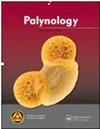Palynotaxonomy of species of Dendrophorbium (Asteraceae: Senecioneae) occurring in Brazil
IF 1.3
4区 地球科学
Q3 PALEONTOLOGY
引用次数: 0
Abstract
AbstractThis article presents a pollen study of 13 species of Dendrophorbium (Asteraceae: Senecioneae) occurring in Brazil. Dendrophorbium has species distributed in the South and Southeast regions of the Brazilian territory that were previously grouped in Senecio Myriocephalus sect. and later Dendrophorbium was elevated to the rank of genus, considering the section Myriocephalus as a synonym of Dendrophorbium. The aim of this study is to advance knowledge of the pollen characteristics of the genus and thus contribute to the taxonomy of the group. The botanical material was collected from specimens deposited in national herbaria. Floral buds were acetolysed for light microscopic analysis. Pollen sediments were mounted on slides with glycerinated gelatin and analyzed under a light microscope. Measurements were taken of the diameters and thickness of exine layers of pollen grains. Examination showed pollen grains to be monadic, isopolar, medium-sized, oblate-spheroidal to prolate-spheroidal, and 3-colporate. The endoaperture has median constriction in most species, except in D. pellucidinerve. The sexine is thicker than the nexine and echinate, with large perforations at the base of echinae. The exine is caveate. Based on the results, it can be concluded that the pollen grains of the 13 Dendrophorbium species are homogeneous and can be differentiated by aperture shape and dimensions and echinus characteristics.Keywords: CompositaemorphologyPalynologytaxonomyDisclaimerAs a service to authors and researchers we are providing this version of an accepted manuscript (AM). Copyediting, typesetting, and review of the resulting proofs will be undertaken on this manuscript before final publication of the Version of Record (VoR). During production and pre-press, errors may be discovered which could affect the content, and all legal disclaimers that apply to the journal relate to these versions also. Declaration of Competing InterestThe authors declare that they have no known competing financial interests or personal relationships that could have appeared to influence the work reported in this paper.The authors declare that have no conflict of interest.Data availabilityAll data supporting the findings of this study are available from the corresponding author.AcknowledgementsV. Esteves and C. B. F. Mendonça are grateful to the Brazilian National Council for Scientific and Technological Development (CNPq) for the research grant (nos. 304910/2019-8, 31618/2021-9). All authors thank the Rio de Janeiro State Research Foundation (FAPERJ) (grant nos. 26.0003/015254/2021 and 260003/015254/2021). We are grateful to the Brazilian Federal Agency for Support and Evaluation of Graduate Education (CAPES) and the Post-Graduate Support Program (PROAP) for awarding scholarships. We also thank the herbarium curators for providing access to their collections and the Scanning Microscopy Laboratory, National Museum, Federal University of Rio de Janeiro, Brazil, for conducting the analyses.产自巴西的石斛属植物的孢粉分类
摘要本文报道了巴西13种石斛属植物(菊科:石斛科)的花粉研究。Dendrophorbium有分布在巴西南部和东南部地区的种,以前被归为Senecio Myriocephalus组,后来将Dendrophorbium提升到属的级别,将Myriocephalus组视为Dendrophorbium的同义词。本研究的目的是提高对该属花粉特征的认识,从而有助于该类群的分类。植物材料来源于国家植物标本馆保存的标本。花蕾被乙酰化用于光镜分析。将花粉沉积物装在甘油明胶载玻片上,在光学显微镜下进行分析。测定了花粉粒的外皮直径和厚度。花粉粒为单形、等极性、中等大小、扁球状至长球状和3合生。大多数种的内孔有中间缩窄,除了在D. pellucidinerve。阴部比内阴部和棘刺粗,在棘刺基部有大的穿孔。外壁呈空泡状。结果表明,13种石斛属植物的花粉粒具有较强的同质性,可通过花粉孔的形状、大小和棘突特征进行区分。关键词:合成词形词类分类免责声明作为对作者和研究人员的服务,我们提供此版本的已接受稿件(AM)。在最终出版版本记录(VoR)之前,将对该手稿进行编辑、排版和审查。在制作和印前,可能会发现可能影响内容的错误,所有适用于期刊的法律免责声明也与这些版本有关。竞争利益声明作者声明,他们没有已知的竞争经济利益或个人关系,可能会影响本文所报道的工作。作者声明没有利益冲突。数据可得性支持本研究结果的所有数据均可从相应作者处获得。Esteves和C. B. F. mendonapera感谢巴西国家科学技术发展委员会(CNPq)的研究资助(no . 304910/2019- 8,31618 /2021-9)。所有作者感谢里约热内卢州研究基金会(FAPERJ)(批准号26.0003/015254/2021和260003/015254/2021)。我们感谢巴西联邦研究生教育支持和评估机构(CAPES)和研究生支持计划(PROAP)颁发奖学金。我们也感谢植物标本馆馆长提供他们的藏品,感谢巴西里约热内卢联邦大学国家博物馆扫描显微镜实验室进行分析。
本文章由计算机程序翻译,如有差异,请以英文原文为准。
求助全文
约1分钟内获得全文
求助全文
来源期刊

Palynology
地学-古生物学
CiteScore
3.40
自引率
26.70%
发文量
48
审稿时长
>12 weeks
期刊介绍:
Palynology is an international journal, and covers all aspects of the science. We accept papers on both pre-Quaternary and Quaternary palynology and palaeobotany. Contributions on novel uses of palynology, review articles, book reviews, taxonomic studies and papers on methodology are all actively encouraged.
 求助内容:
求助内容: 应助结果提醒方式:
应助结果提醒方式:


